Joint Failure Probability of Dams Based on Probabilistic Flood Hazard Analysis
Abstract
1. Introduction
1.1. Background
1.2. Probabilistic Flood Hazard Analysis (PFHA)
1.3. Stochastic Modeling
1.3.1. Stochastic Modeling Overview
1.3.2. Stochastic Modeling Applications
1.3.3. The Stochastic Event Flood Model (SEFM)
1.3.4. Advantages of SEFM
1.4. Study Objectives
2. Data and Methods
2.1. Study Area
2.2. Input Data for Stochastic Simulations
- Watershed Precipitation Depth: The watershed precipitation depth was obtained from the precipitation frequency curve for a given storm (see Section 2.2.3). Precipitation sampling bins were specified across a defined sampling range for stratification of the precipitation frequency curve as described in Section 2.3.1.
- Storm Templates: The spatial distribution of rainfall was obtained from defined storm templates for MLC, MEC, and TSR storms as described in Section 2.2.1 and Section 2.2.2. An AEP range was associated with each storm template, and relative weighting factors were applied to storm templates to determine sampling frequency.
- Seasonality: the probability of specific storm types occurring at specific times of the year was defined based on historical observations within the Tennessee River watershed, influencing the likelihood of certain types of storms being sampled at specific dates in the long-term simulation.
- Initial Conditions: soil moisture states, reservoir states, and river states were obtained from the long-term simulation.
- Storm Insertion Dates: valid dates to insert storms were identified within the long-term simulation according to wet and dry periods and the storm type being sampled.
2.2.1. Storm Types
- Mid-Latitude Cyclones (MLCs): synoptic scale storms most commonly occurring in the winter period with extended durations and gradually varying precipitation gradients.
- Tropical Storm Remnants (TSRs): decadent tropical storms that impact very large areas with low-to-moderate precipitation intensities generating large total precipitation volumes over several days, occurring during the Atlantic hurricane season.
- Mesoscale Storms with Embedded Convection (MECs): commonly referred to as summer thunderstorms, smaller scale convective storms with high-intensity precipitation clusters of convective cells in addition to low-to-moderate intensity precipitation in areas surrounding convective cells, characterized by shorter durations and chaotic spatial distribution of precipitation.
2.2.2. Storm Templates
2.2.3. Precipitation Frequency Relationships
2.2.4. Initial Conditions from Long-Term Simulation
2.3. Stochastic Calculations
- Sample precipitation depth: the watershed precipitation frequency curve is used to sample the precipitation depth at the key duration of the specified storm type (e.g., 48 h for MLC and TSR, 6 h for MEC).
- Sample storm template: The spatial and temporal distribution of the storm is determined by sampling from the available set of storm templates. An AEP range limits when a storm template may be selected based on the probability of the sampled rainfall event.
- Scale the storm template: the selected storm template is then scaled such that the average storm depth across the watershed is equal to the depth of precipitation sampled from the precipitation frequency curve.
- Sample date from long-term simulation: a date is randomly sampled from the long-term simulation in accordance with the seasonality of the storm type under consideration and is used to set the initial conditions for the stochastic event and define its placement within the overall precipitation time series.
- Insert stochastic event: MLC, MEC, and TSR storms are inserted within the context of the continuous precipitation time series from the long-term simulation. A dry period of 48 h is maintained before and after MLC and TSR events. Three sub-types of MEC storms (isolated, multi-day, and hybrid) are defined based on the precipitation surrounding an MEC event (MEC events may be embedded within other storms). The sampling algorithm considers the appropriate type of MEC storm to insert on a given date and the probability associated with the given sub-type in each season.
- Execute stochastic event simulation and compute statistics: After establishing the precipitation sequence and initial conditions, watershed and operational models can be executed to route the stochastic event. The output statistics from watershed models (e.g., peak headwater, peak discharge) are collected and used in the analysis of hydrologic hazards and creation of hydrologic hazard curves.
2.3.1. Stratified Sampling and Convergence
2.4. Stochastic Model Calibration
2.5. Empirical Method to Determine Bivariate Exceedance Probabilities
2.6. Calculation of Bivariate Empirical Failure Probability
2.6.1. Failure Estimate from Generalized Spillway Fragility Curves
3. Results
3.1. Assessment of Discharge Correlation
3.2. Probability Surfaces Based on Dam Combination and Storm Type
3.2.1. Spillway Discharge Pair Exceedance Probability
3.2.2. Joint Failure Probability
3.3. Best Estimate of Bivariate and Univariate Failure Probability
4. Discussion
4.1. Discharge Correlation
4.2. Assessment of Discharge and Failure Probabilities
4.2.1. Bivariate Discharge Pair Exceedance Probabilities
4.2.2. Bivariate Failure Probabilities
4.2.3. Univariate and Bivariate Best Estimate of Failure Probability
4.3. Characterization of System Risk
4.4. Factors Influencing Sensitivity of Stochastic Simulation Results
4.4.1. Hydrologic Model Structure
4.4.2. Model Inputs
4.5. Future Work and Applications
5. Conclusions
Author Contributions
Funding
Data Availability Statement
Acknowledgments
Conflicts of Interest
References
- Smith, C.H.; Bartles, M.; Fleming, M. Hydrologic Hazard Methodology for Semi-Quantitative Risk Assessments: An Inflow Volume-Based Approach to Estimating Stage-Frequency for Dams. In USACE RMC-TR-2018-03; United States Army Corps of Engineers: Washington, DC, USA, 2018. [Google Scholar]
- Fleming, M.J.; Duren, A. Stochastic Hydrologic Simulation for Extension of Reservoir Pool Stage Frequency Curves. In Proceedings of the World Environmental and Water Resources Congress, Austin, TX, USA, 17–21 May 2015. [Google Scholar] [CrossRef]
- England, J.F., Jr.; Cohn, T.A.; Faber, B.A.; Stedinger, J.R.; Thomas, W.O., Jr.; Veilleux, A.G.; Kiang, J.E.; Mason, R.R., Jr. Guidelines for Determining Flood Flow Frequency—Bulletin 17C. U.S. Geological Survey Techniques and Methods, 2018, Book 4, Chap. B5, 148. Available online: https://pubs.usgs.gov/tm/04/b05/tm4b5.pdf (accessed on 1 October 2022).
- Newman, A.J.; Stone, A.G.; Saharia, M.; Holman, K.D.; Addor, N.; Clark, M.P. Identifying sensitivities in flood frequency analyses using a stochastic hydrologic modeling system. Hydrol. Earth Syst. Sci. 2021, 25, 5603–5621. [Google Scholar] [CrossRef]
- Zhang, L.; Singh, V.P. Bivariate Flood Frequency Analysis Using the Copula Method. J. Hydrol. Engr. 2006, 11, 150–164. [Google Scholar] [CrossRef]
- Requena, A.I.; Mediero, L.; Garrote, L. A bivariate return period based on copulas for hydrologic dam design: Accounting for reservoir routing in risk estimation. Hydrol. Earth Syst. Sci. 2013, 17, 3023–3038. [Google Scholar] [CrossRef]
- Micovic, Z.; Hartford, D.N.D.; Schaefer, M.G.; Barker, B.L. A non-traditional approach to the analysis of flood hazard for dams. Stoch. Environ. Res. Risk Assess. 2016, 30, 559–581. [Google Scholar] [CrossRef]
- Donnelly, C.R.; Acharya, A.M. A Discussion on the Evolution and Application of Quantitative Risk Informed Dam Safety Decision Making. In ICDSME 2019. Water Resources Development and Management; Mohd Sidek, L., Salih, G., Boosroh, M., Eds.; Springer: Singapore, 2020. [Google Scholar] [CrossRef]
- U.S. Water Resources Council. A Uniform Technique for Determining Flood Flow Frequencies, 1967. Technical Bulletin No. 15. U.S. Water Resources Council, Subcommittee on Hydrology, Washington, DC. Available online: https://water.usgs.gov/osw/bulletin17b/Bulletin_15_1967.pdf (accessed on 1 October 2022).
- Interagency Committee on Water Data. Guidelines for Determining Flood Flow Frequency, Technical Report Bulletin 17B: 1982. Interagency Committee on Water Data, Hydrology Subcommittee. Available online: https://relicensing.pcwa.net/documents/Library/PCWA-L%20465.pdf (accessed on 1 October 2022).
- Thomas, W.O. A uniform technique for flood frequency analysis. J. Water Resour. Plan. Manag. 1985, 111, 321–337. [Google Scholar] [CrossRef]
- Griffis, V.W.; Stedinger, J.R. Evolution of flood frequency analysis with Bulletin 17. J. Hydrol. Eng. 2007, 12, 283–297. [Google Scholar] [CrossRef]
- Cohn, T.A.; England, J.F.; Berenbrock, C.E.; Mason, R.R.; Stedinger, J.R.; Lamontagne, J.R. A generalized Grubbs-Beck test statistic for detecting multiple potentially influential low outliers in flood series. Water Resour. Res. 2013, 49, 5047–5058. [Google Scholar] [CrossRef]
- National Research Council. Estimating Probabilities of Extreme Floods: Methods and Recommended Research; National Academy Press: Washington, DC, USA, 1988. [Google Scholar] [CrossRef]
- Packman, J.; Kidd, C. A logical approach to the design storm concept. Water Resour. Res. 1980, 16, 994–1000. [Google Scholar] [CrossRef]
- Wright, D.B.; Yu, G.; England, J.F. Six decades of rainfall and flood frequency analysis using stochastic storm transposition: Review, progress, and prospects. J. Hydrol. 2020, 585, 124816. [Google Scholar] [CrossRef]
- Wright, D.B.; Smith, J.A.; Baeck, M.L. Flood frequency analysis using radar rainfall fields and stochastic storm transposition. Water Resour. Res. 2014, 50, 1592–1615. [Google Scholar] [CrossRef]
- Schaefer, M.G.; Barker, B.L. Stochastic Event Flood Model (SEFM). In Mathematical Models of Small Watershed Hydrology and Applications; Singh, V.J., Frevert, D.K., Eds.; Water Resources Publications LLC.: Littleton, CO, USA, 2002; Section 5; pp. 705–745. ISBN 1-887201-35-1. Available online: https://www.cabdirect.org/cabdirect/abstract/20033121363 (accessed on 1 October 2022).
- England, J.E., Jr.; Godaire, J.E.; Klinger, R.E.; Bauer, T.R.; Julien, P.Y. Paleohydrologic bounds and extreme flood frequency of the Upper Arkansas River, Colorado, USA. Geomorphology 2010, 124, 1–16. [Google Scholar] [CrossRef]
- Paquet, E.; Garavaglia, F.; Garçon, R.; Gailhard, J. The SCHADEX method: A semi-continuous rainfall–runoff simulation for extreme flood estimation. J. Hydrol. 2013, 495, 23–37. [Google Scholar] [CrossRef]
- Sharma, A.; Wasko, C.; Lettenmaier, D.P. If precipitation extremes are increasing, why aren’t floods? Water Resour. Res. 2018, 54, 8545–8551. [Google Scholar] [CrossRef]
- Nuswantoro, R.; Diermanse, F.; Molkenthin, F. Probabilistic flood hazard maps for Jakarta. J. Flood Risk Manag. 2016, 9, 105–124. [Google Scholar] [CrossRef]
- Wing, O.E.J.; Quinn, N.; Bates, P.D.; Neal, J.C.; Smith, A.M.; Sampson, C.C.; Coxon, G.; Yamazaki, D.; Sutanudjaja, E.H.; Alfieri, L. Toward global stochastic river flood modeling. Water Resour. Res. 2020, 56, e2020WR027692. [Google Scholar] [CrossRef]
- Schaefer, M.G.; Barker, B.L. Stochastic Event Flood Model (SEFM) User’s Manual; MGS Engineering Consultants, Inc. & MGS Software LLC.: Olympia WA, USA, 2017; Available online: https://mgsengr.com/wp-content/download/SEFM_TechnicalSupportManual_March2018.pdf (accessed on 1 October 2022).
- Steinschneider, S.; Brown, C. A semiparametric multivariate, multi-site weather generator with low-frequency variability for use in climate risk assessments. Water Resour. Res. 2013, 49, 7205–7220. [Google Scholar] [CrossRef]
- Diermanse, F.L.M.; Carroll, D.G.; Beckers, J.V.L.; Ayre, R.; Schuurmans, J.M. A Monte Carlo Framework for the Brisbane River Catchment Flood Study. In Proceedings of the HWRS Conference, Perth, Australia, 24–27 February 2014; Available online: https://search.informit.org/doi/10.3316/informit.386923464782388 (accessed on 1 October 2022).
- Rahman, A.; Weinmann, P.E.; Hoang, T.M.T.; Laurenson, E.M. Monte Carlo simulation of flood frequency curves from rainfall. J. Hydrol. 2002, 256, 196–210. [Google Scholar] [CrossRef]
- Zhu, Z.; Wright, D.B.; Yu, G. The impact of rainfall space-time structure in flood frequency analysis. Water Resour. Res. 2018, 54, 8983–8998. [Google Scholar] [CrossRef]
- Hunter, R.D.; Meentemeyer, R.K. Climatologically aided mapping of daily precipitation and temperature. J. Appl. Meteor. Climatol. 2005, 44, 1501–1510. [Google Scholar] [CrossRef]
- Lobligeois, F.; Andréassian, V.; Perrin, C.; Tabary, P.; Loumagne, C. When does higher spatial resolution rainfall information improve streamflow simulation? An evaluation using 3620 flood events. Hydrol. Earth Syst. Sci. 2014, 18, 575–594. [Google Scholar] [CrossRef]
- Shaw, E.M.; Beven, K.J.; Chappell, N.A.; Lamb, R. Hydrology in Practice, 4th ed.; Spon Press: New York, NY, USA, 2011. [Google Scholar]
- Micovic, Z.; Schaefer, M.G.; Taylor, G.H. Uncertainty analysis for Probable Maximum Precipitation estimates. J. Hydrol. 2015, 521, 360–373. [Google Scholar] [CrossRef]
- Hosking, J.R.M.; Wallis, J.R. Regional Frequency Analysis—An Approach Based on L-Moments; Cambridge Press: Cambridge, UK, 1997; Available online: https://ui.adsabs.harvard.edu/abs/1997rfa..book.....H/abstract (accessed on 1 October 2022).
- Schaefer, M.G.; Barker, B.L. Stochastic Modeling of Extreme Floods on the American River at Folsom Dam: Flood-Frequency Curve Extension; US Army Corps of Engineers, Hydrologic Engineering Center: Davis, CA, USA, 2005. Available online: https://www.hec.usace.army.mil/publications/ResearchDocuments/RD-48.pdf (accessed on 1 October 2022).
- MGS Engineering Consultants, MetStat, Applied Climate Services, & Riverside Technology. Regional PF Analyses for Mid-Latitude Cyclones, Mesoscale Storms with Embedded Convection, Local Storms and Tropical Storm Remnant Storm Types in the Tennessee Valley Watershed, Prepared for Tennessee Valley Authority. 2015. Available online: https://mgsengr.com/wp-content/download/SimplifiedSEFM_Guidance_20220527.pdf (accessed on 1 October 2022).
- Peleg, N.; Blumensaat, F.; Molnar, P.; Fatichi, S.; Burlando, P. Partitioning the impacts of spatial and climatological rainfall variability in urban drainage modeling. Hydrol. Earth Syst. Sci. 2017, 21, 1559–1572. [Google Scholar] [CrossRef]
- Bennett, T.H. Development and Application of a Continuous Soil Moisture Accounting Algorithm for the Hydrologic Engineering Center Hydrologic Modeling System (HEC-HMS); University of California: Davis, CA, USA, 1998. [Google Scholar]
- Zagona, E.A.; Fulp, T.J.; Shane, R.; Magee, T.; Goranflo, H.M. RiverWare: A generalized tool for complex reservoir system modeling. J. Am. Water Resour. Assoc. 2001, 37, 913–929. [Google Scholar] [CrossRef]
- Neyman, J. On the two different aspects of the representative method: The method of stratified sampling and the method of purposive selection. J. R. Stat. Soc. 1934, 97, 558–625. [Google Scholar] [CrossRef]
- Benjamin, J.R.; Cornell, C.A. Probability and Statistics for Civil Engineers; McGraw-Hill: New York, NY, USA, 1970. [Google Scholar]
- Kuczera, G. Combining site-specific and regional information an empirical Bayes approach. Water Resour. Res. 1982, 18, 306–314. [Google Scholar] [CrossRef]
- Nathan, R.J.; Weinmann, E.M.; Hill, P. Use of Monte Carlo Simulation to Estimate the Expected Probability of Large to Extreme Floods. In Proceedings of the 28th International Hydrology and Water Resources Symposium, Wollongong, NSW, Australia, 10–14 November 2003; The Institution of Engineers: Australian Capital Territory, Australia, 2003. Available online: https://search.informit.org/doi/10.3316/informit.350910043129567 (accessed on 1 October 2022).
- Tijms, H.C. A First Course in Stochastic Models; John Wiley and Sons: West Sussex, UK, 2003; ISBN 13 978 0471498803. [Google Scholar]
- Korn, E.I.; Graubard, B.I. Confidence intervals for proportions with small expected number of positive counts estimated from survey data. Surv. Methodol. 1998, 24, 193–201. [Google Scholar]
- Newman, A.J.; Mizukami, N.; Clark, M.P.; Wood, A.W.; Nijssen, B.; Nearing, G. Benchmarking of a physically based hydrologic model. J. Hydrometeorol. 2017, 18, 2215–2225. [Google Scholar] [CrossRef]
- Clark, M.P.; Slater, A.G.; Rupp, D.E.; Woods, R.A.; Vrugt, J.A.; Gupta, H.V.; Wagener, T.; Hay, L.E. Framework for Understanding Structural Errors (FUSE): A modular framework to diagnose differences between hydrological models. Water Resour. Res. 2008, 44, W00B02. [Google Scholar] [CrossRef]
- Markstrom, S.L.; Hay, L.E.; Clark, M.P. Towards simplification of hydrologic modeling: Identification of dominant processes. Hydrol. Earth Syst. Sci. 2016, 20, 4655–4671. [Google Scholar] [CrossRef]
- Mizukami, N.; Rakovec, O.; Newman, A.J.; Clark, M.P.; Wood, A.W.; Gupta, H.V.; Kumar, R. On the choice of calibration metrics for “high-flow” estimation using hydrologic models. Hydrol. Earth Syst. Sci. 2019, 23, 2601–2614. [Google Scholar] [CrossRef]
- Anderson, E.A. Calibration of Conceptual Hydrologic Models for Use in River Forecasting; Office of Hydrologic Development, US National Weather Service: Silver Spring, MD, USA, 2002. Available online: https://www.weather.gov/media/owp/oh/hrl/docs/1_Anderson_CalbManual.pdf (accessed on 1 October 2022).
- Yu, G.; Wright, D.B.; Zhu, Z.; Smith, C.; Holman, K.D. Process-based flood frequency analysis in an agricultural watershed exhibiting nonstationary flood seasonality. Hydrol. Earth Syst. Sci. 2019, 23, 2225–2243. [Google Scholar] [CrossRef]
- Yakir, H.; Morin, E. Hydrologic response of a semi-arid watershed to spatial and temporal characteristics of convective rain cells. Hydrol. Earth Syst. Sci. 2011, 15, 393–404. [Google Scholar] [CrossRef]
- JMP Version Pro 16.0.0, SAS Institute Inc.: Cary, NC, USA,, 2021. Available online: https://www.jmp.com/en_us/software.html (accessed on 1 October 2022).
- The MathWorks Inc. MATLAB Version: 9.13.0 (R2022b), The MathWorks Inc.: Natick, MA, USA, 2022. Available online: https://www.mathworks.com (accessed on 1 October 2022).

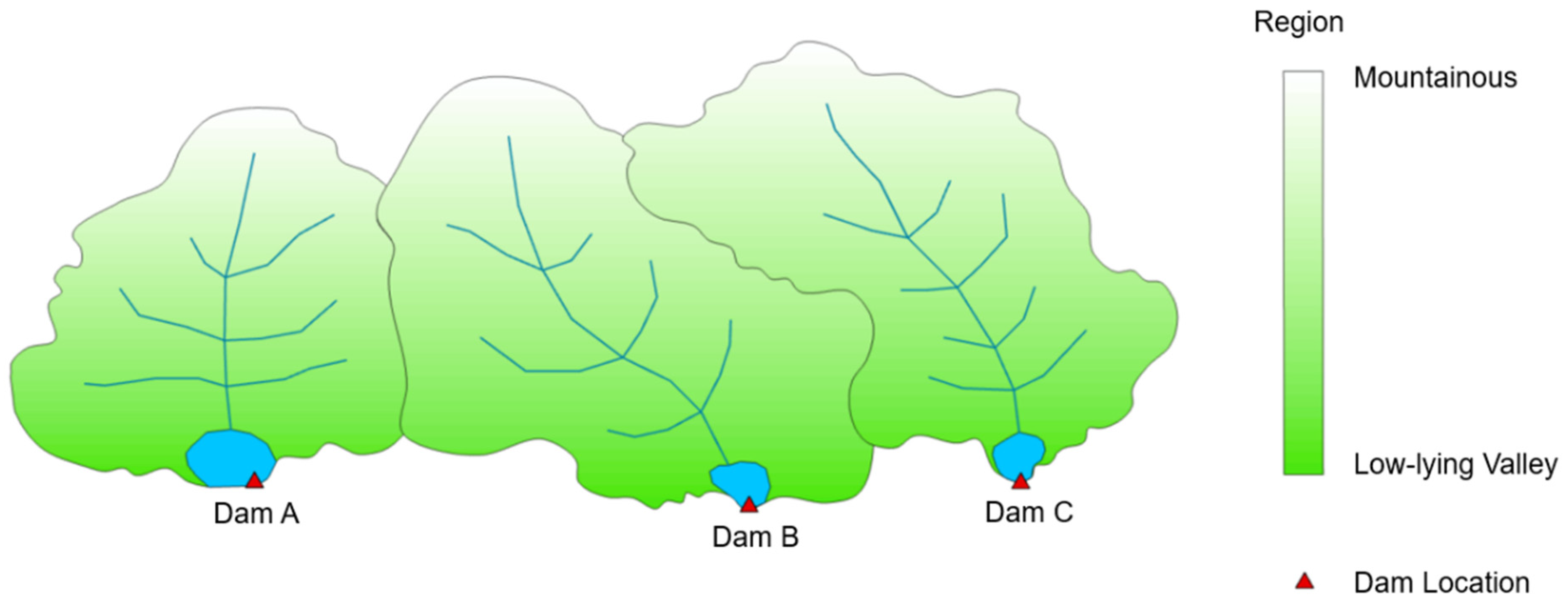
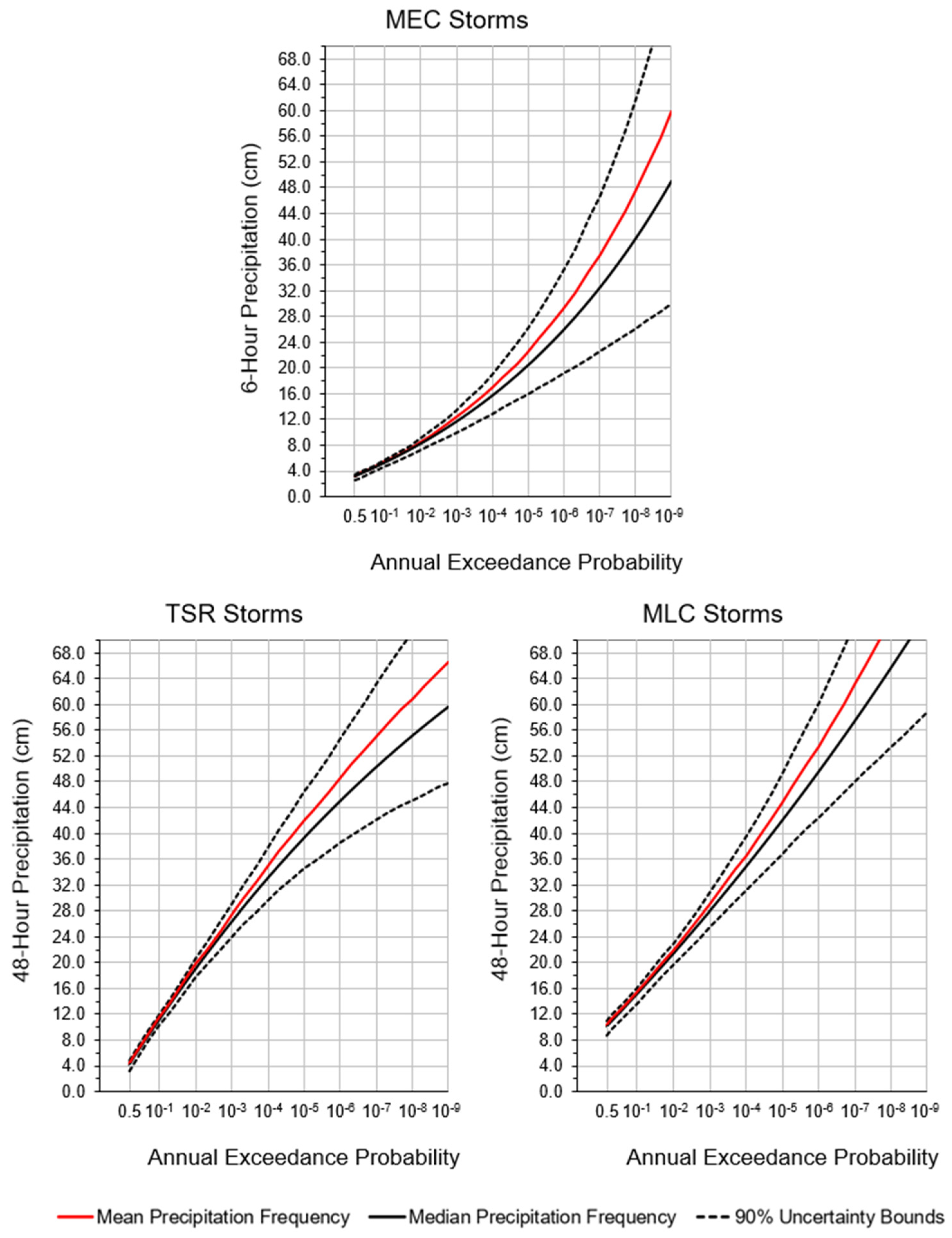
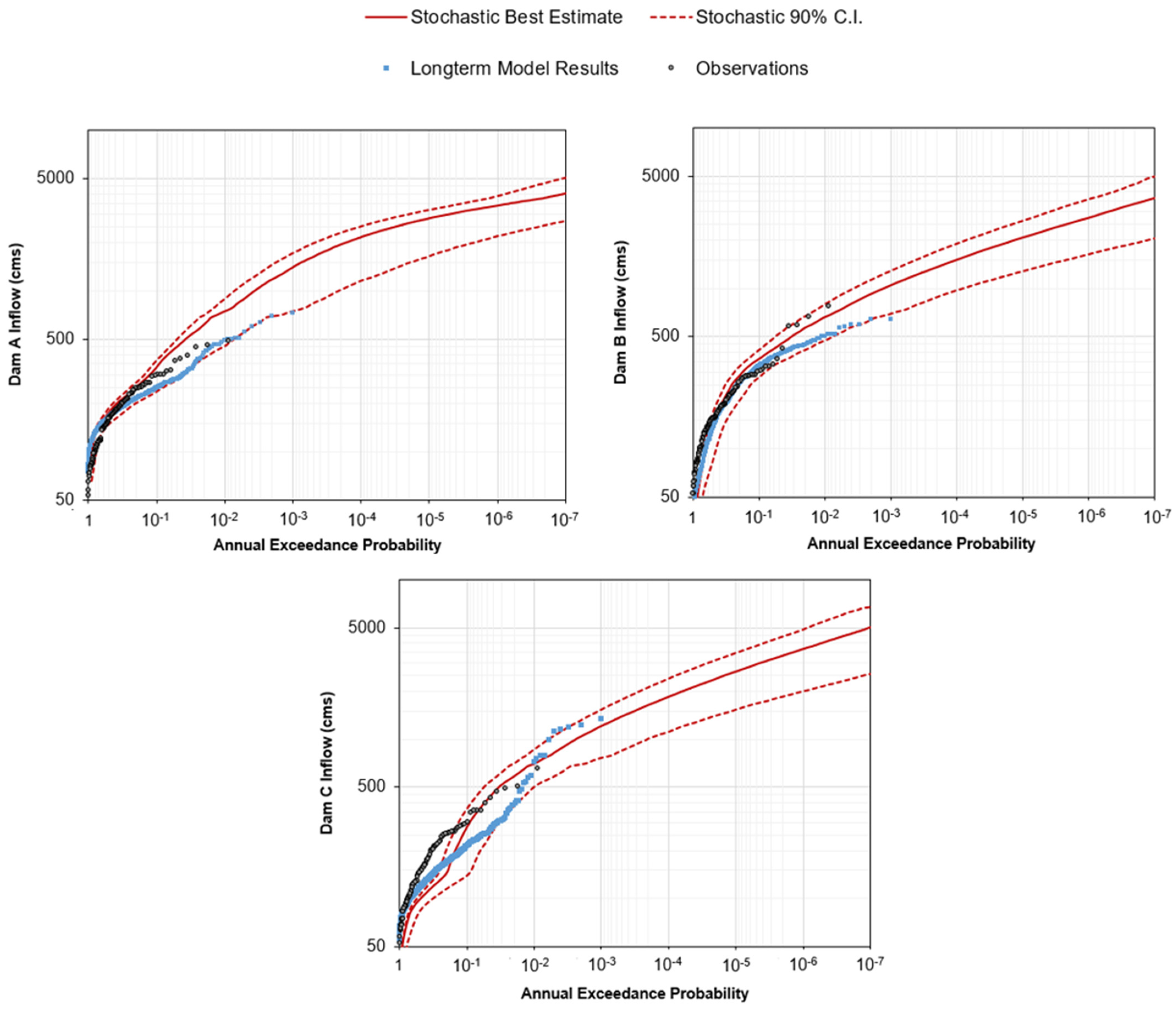
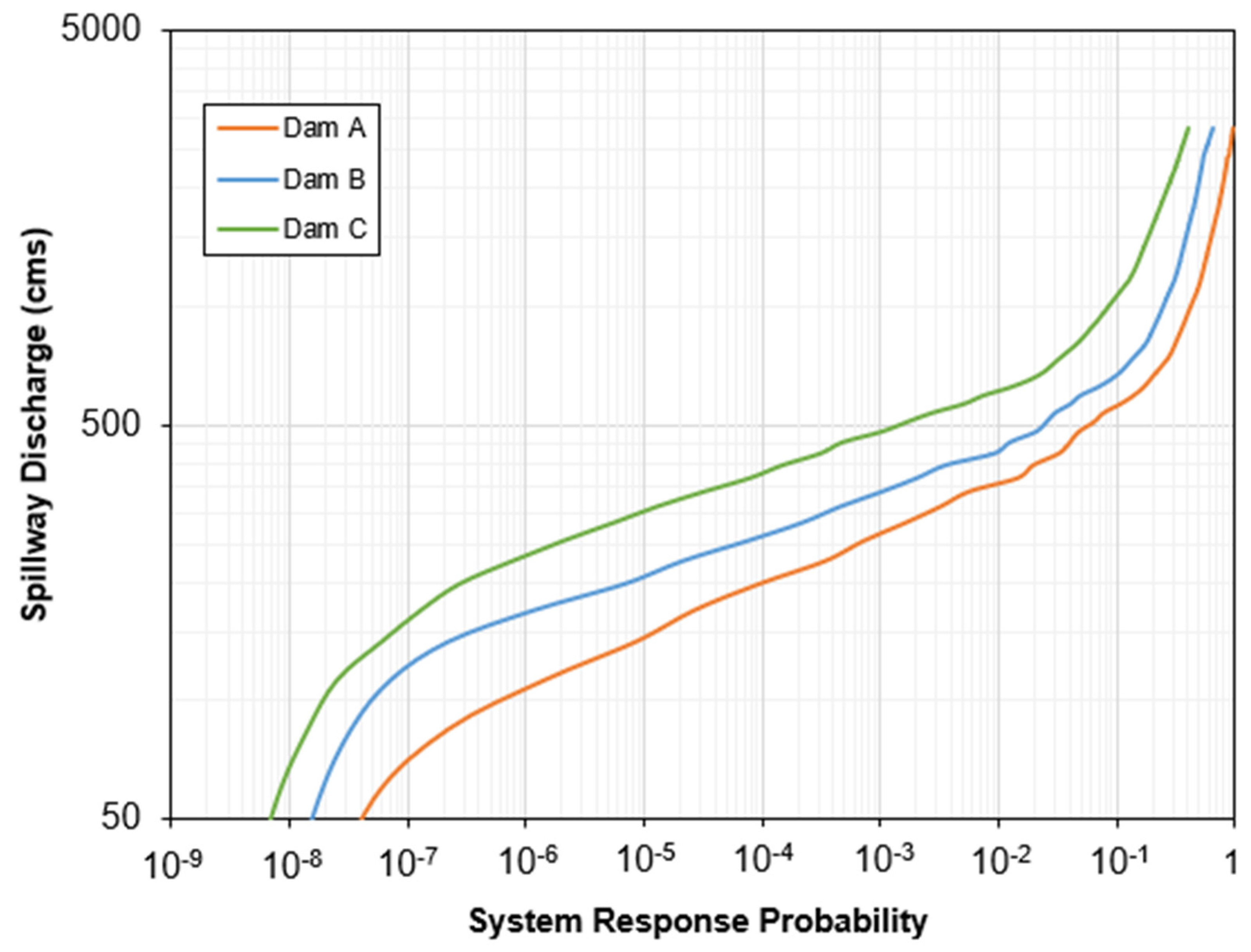
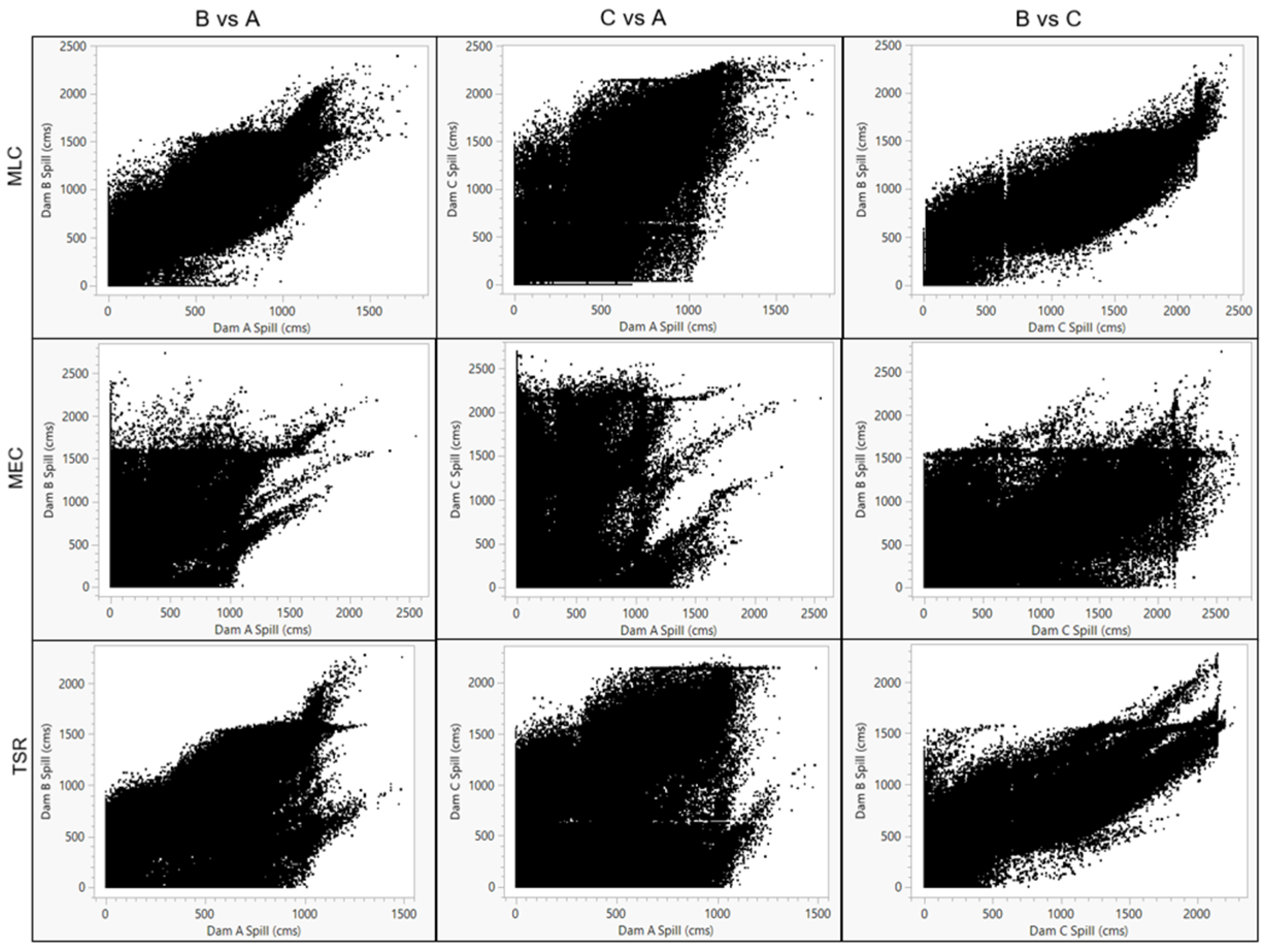

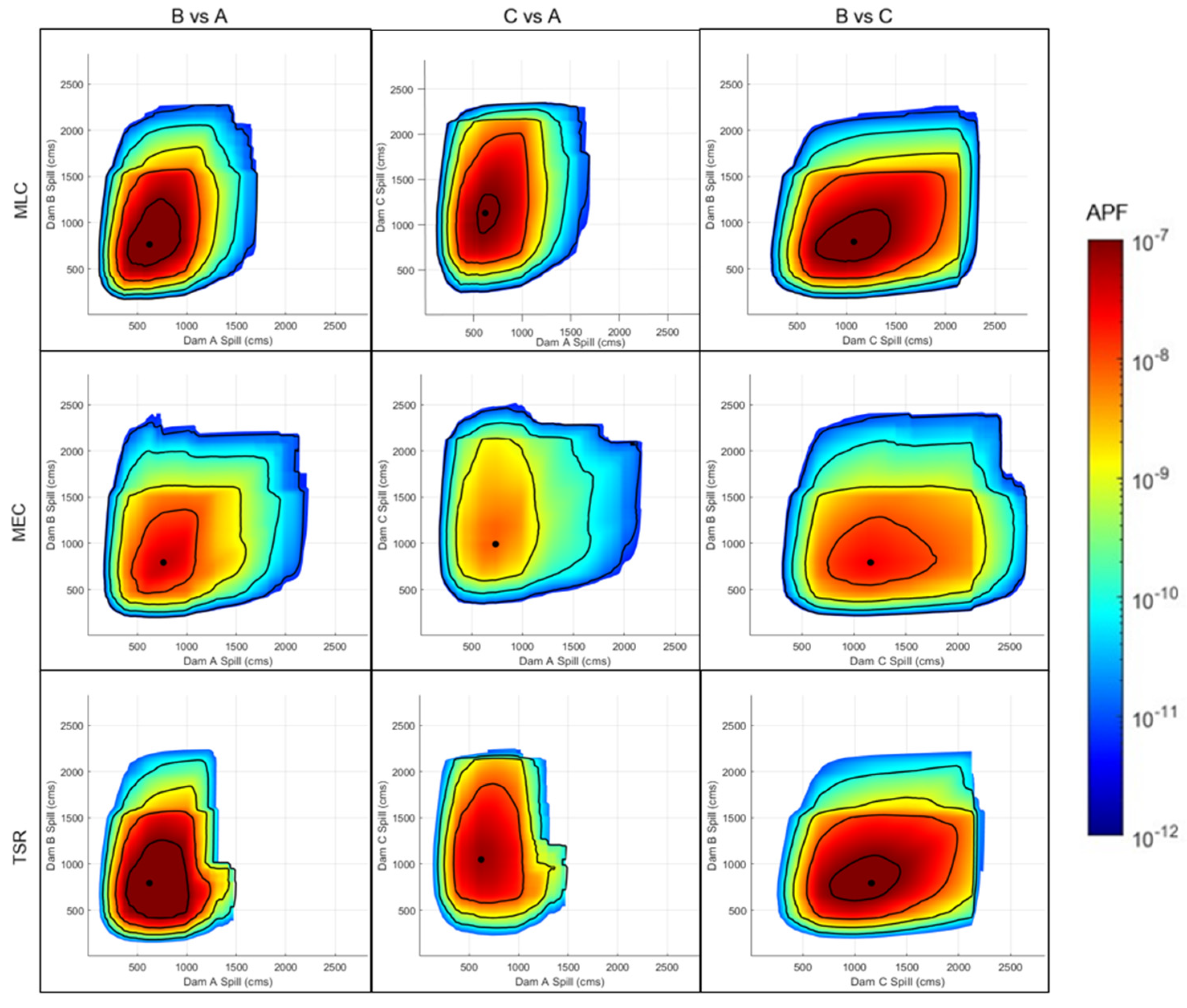

| Storm Types | Simulation Count | Dam (Combination) | Peak Spillway Discharge | |||
|---|---|---|---|---|---|---|
| Mean (cms) | Std. Dev. (cms) | Correlation | Covariance (×108) | |||
| MLC | 180,942 | A | 565 | 338 | -- | -- |
| B | 851 | 462 | -- | -- | ||
| C | 1029 | 639 | -- | -- | ||
| (A, B) | -- | -- | 0.861 | 1.675 | ||
| (A, C) | -- | -- | 0.812 | 2.183 | ||
| (C, B) | -- | -- | 0.908 | 3.340 | ||
| MEC | 160,021 | A | 264 | 362 | -- | -- |
| B | 505 | 471 | -- | -- | ||
| C | 580 | 668 | -- | -- | ||
| (A, B) | -- | -- | 0.572 | 1.214 | ||
| (A, C) | -- | -- | 0.181 | 0.545 | ||
| (C, B) | -- | -- | 0.644 | 2.527 | ||
| TSR | 188,872 | A | 356 | 318 | -- | -- |
| B | 556 | 451 | -- | -- | ||
| C | 543 | 587 | -- | -- | ||
| (A, B) | -- | -- | 0.674 | 1.204 | ||
| (A, C) | -- | -- | 0.517 | 1.202 | ||
| (C, B) | -- | -- | 0.855 | 2.821 | ||
| Storm Type | Dam (Combination) | Spill (cms) | Hydrologic Exceedance Probability | System Response Probability | System Failure Probability |
|---|---|---|---|---|---|
| MLC | (A, B) | (620, 760) | 1.118 × 10−5 | 2.501 × 10−2 | 2.795 × 10−7 |
| (A, C) | (620, 1100) | 7.680 × 10−6 | 1.798 × 10−2 | 1.371 × 10−7 | |
| (C, B) | (1000, 760) | 1.732 × 10−5 | 1.449 × 10−2 | 2.510 × 10−7 | |
| MEC | (A, B) | (760, 790) | 9.261 × 10−7 | 4.854 × 10−2 | 4.495 × 10−8 |
| (A, C) | (740, 990) | 3.727 × 10−7 | 2.193 × 10−2 | 8.173 × 10−9 | |
| (C, B) | (1200, 790) | 1.131 × 10−6 | 2.125 × 10−2 | 2.403 × 10−8 | |
| TSR | (A, B) | (620, 790) | 1.416 × 10−5 | 2.797 × 10−2 | 3.961 × 10−7 |
| (A, C) | (620, 1000) | 4.438 × 10−6 | 1.569 × 10−2 | 6.964 × 10−8 | |
| (C, B) | (1200, 790) | 9.005 × 10−6 | 2.125 × 10−2 | 1.914 × 10−7 |
| Dam (Combination) | Spill (cms) | Hydrologic Exceedance Probability | System Response Probability | System Failure Probability |
|---|---|---|---|---|
| A | 590 | 3.650 × 10−4 | 1.367 × 10−1 | 4.991 × 10−5 |
| B | 650 | 1.624 × 10−4 | 8.751 × 10−2 | 1.421 × 10−5 |
| C | 990 | 6.893 × 10−5 | 8.274 × 10−2 | 5.703 × 10−6 |
| (A, B) | (620, 760) | 2.822 × 10−5 | 2.501 × 10−2 | 7.059 × 10−7 |
| (A, C) | (620, 1100) | 1.146 × 10−5 | 1.798 × 10−2 | 2.061 × 10−7 |
| (C, B) | (1100, 790) | 2.651 × 10−5 | 1.737 × 10−2 | 4.604 × 10−7 |
Disclaimer/Publisher’s Note: The statements, opinions and data contained in all publications are solely those of the individual author(s) and contributor(s) and not of MDPI and/or the editor(s). MDPI and/or the editor(s) disclaim responsibility for any injury to people or property resulting from any ideas, methods, instructions or products referred to in the content. |
© 2024 by the authors. Licensee MDPI, Basel, Switzerland. This article is an open access article distributed under the terms and conditions of the Creative Commons Attribution (CC BY) license (https://creativecommons.org/licenses/by/4.0/).
Share and Cite
Montgomery, M.G.; Yaw, M.B.; Schwartz, J.S. Joint Failure Probability of Dams Based on Probabilistic Flood Hazard Analysis. Water 2024, 16, 865. https://doi.org/10.3390/w16060865
Montgomery MG, Yaw MB, Schwartz JS. Joint Failure Probability of Dams Based on Probabilistic Flood Hazard Analysis. Water. 2024; 16(6):865. https://doi.org/10.3390/w16060865
Chicago/Turabian StyleMontgomery, Matthew G., Miles B. Yaw, and John S. Schwartz. 2024. "Joint Failure Probability of Dams Based on Probabilistic Flood Hazard Analysis" Water 16, no. 6: 865. https://doi.org/10.3390/w16060865
APA StyleMontgomery, M. G., Yaw, M. B., & Schwartz, J. S. (2024). Joint Failure Probability of Dams Based on Probabilistic Flood Hazard Analysis. Water, 16(6), 865. https://doi.org/10.3390/w16060865








